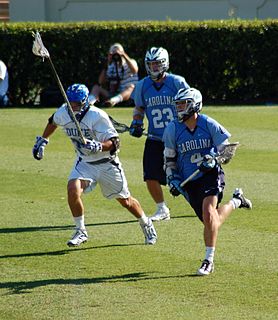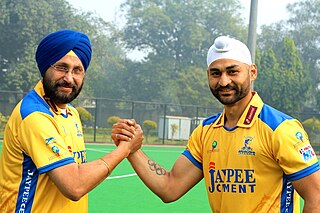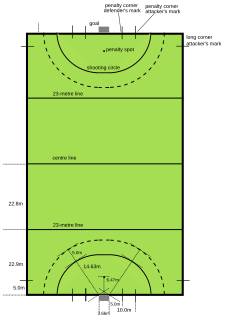
Bandy is a team winter sport played on ice, in which players on ice skates use sticks to direct a ball into the opposing team's goal. This ball-sport is one of the fastest team sports on ice and also belongs to a small group of four ice skating team sports, irrespective of their associated variants, which now includes ice hockey, ringette, and rinkball. Bandy is the only ice skating sport in the world played on a bandy field which is a sheet of ice that is considerably larger than a standard ice rink. The goal cage used in bandy is also the largest one used out of all four sports, at 3.5 m wide and 2.1 m.

Field hockey is a team sport of the hockey family. Each team plays with ten field players and a goalkeeper, and must carry a round, hard, plastic hockey ball with a hockey stick to the rival goal.

Floorball is a type of floor hockey with five players and a goalkeeper in each team. Men and women play indoors with 96–115.5 cm-long (37.8–45.5 in) sticks and a 70–72 mm-diameter (2.76–2.83 in) plastic ball with holes. Matches are played in three twenty-minute periods. Floorball was included in the World Games for the first time in 2017 in Wrocław, Poland. Sweden were the first World Games gold medal winners.

Lacrosse is a team sport played with a lacrosse stick and a lacrosse ball. It is the oldest organized sport in North America, with its origins in indigenous Canada as early as the 17th century. The game was extensively modified by European colonists, reducing the violence, to create its current collegiate and professional form.

In many team sports which involve scoring goals, the goalkeeper is a designated player charged with directly preventing the opposing team from scoring by blocking or intercepting opposing shots on goal. Such positions exist in bandy, rink bandy, camogie, association football, Gaelic football, international rules football, floorball, handball, hurling, field hockey, ice hockey, roller hockey, lacrosse, ringette, rinkball, water polo, and shinty as well as in other sports.
A hockey stick is a piece of sports equipment used by the players in all the forms of hockey to move the ball or puck either to push, pull, hit, strike, flick, steer, launch or stop the ball/puck during play with the objective being to move the ball/puck around the playing area using the stick, and then trying to score.

A penalty in ice hockey is a punishment for an infringement of the rules. Most penalties are enforced by sending the offending player to a penalty box for a set number of minutes. During the penalty the player may not participate in play. Penalties are called and enforced by the referee, or in some cases, the linesman. The offending team may not replace the player on the ice, leaving them short-handed as opposed to full strength. When the opposing team is said to be on a power play, they will have one more player on the ice than the short-handed team. The short-handed team is said to be "on the penalty kill" until the penalty expires and the penalized player returns to play. While standards vary somewhat between leagues, most leagues recognize several common varieties of penalties, as well as common infractions.
Field hockey is a popular game possibly depicted on walls in Egypt. Drawings of what looks to be hockey have been found in an Egyptian tomb that was 4000 years old. Hockey is a popular game in India and Pakistan. It was played for hundreds of years before other countries like England modernised it. Hockey is similar to an ancient game played in Scotland called shinty. Hockey is often played at schools in the UK but its origins are unclear. Later came ice hockey, which developed in Canada.

Indoor hockey is an indoor variant of outdoor "field" hockey. Thus, it is different from floorball and indoor roller hockey variants such as rink hockey or inline hockey.
An umpire in field hockey is a person with the authority to make decisions on a hockey pitch in accordance with the rules of the game. Each match is controlled by two such umpires. In theory they are responsible for decisions taken on their respective half of the field, but practically they 'control' on either diagonal half of the field. In many higher-level events, a reserve umpire is appointed in addition to the two field umpires to act as a back-up in the event of injury or other issue preventing a field umpire from commencing or continuing a match. In World-Level competitions, a video umpire is also appointed in addition to the field and reserve umpires.

Roller inline hockey, or inline hockey is a variant of hockey played on a hard, smooth surface, with players using inline skates to move and hockey sticks to shoot a hard, plastic puck into their opponent's goal to score points. There are five players including the goalkeeper from each team on the rink at a time, while teams normally consist of 16 players.
Sohail Abbas, is a former professional field hockey player from Pakistan who played as a Full-back. Regarded as one of the greatest player of all time he is the highest goal scorer in international field hockey with 348 international goals. A drag-flick specialist noted for his lethal flicks with great accuracy and speed in front of goal from penalty corners he is widely regarded as the 'King of the drag flick'.

In field hockey, a penalty corner, sometimes known as a short corner, is a penalty given against the defending team. It is predominantly awarded for a defensive infringement in the penalty circle or for a deliberate infringement within the defensive 23-metre area. They are eagerly sought by attacking players and provide an excellent opportunity to score. There are particular rules for that only apply at penalty corners and players develop specialist skills, such as the drag flick, for this particular phase in the game.

An ice hockey stick is a piece of equipment used in ice hockey to shoot, pass, and carry the puck across the ice. Ice hockey sticks are approximately 150–200 cm long, composed of a long, slender shaft with a flat extension at one end called the blade. National Hockey League (NHL) sticks are up to 63 inches long. The blade is the part of the stick used to contact the puck, and is typically 25 to 40 cm long. Stick dimensions can vary widely, as they are usually built to suit a particular player's size and preference. The blade is positioned at roughly a 135° angle from the axis of the shaft, giving the stick a partly 'L-shaped' appearance. The shaft of the stick is fairly rigid, but is slightly elastic to improve shot performance.

In field hockey, each player carries a stick and cannot take part in the game without it. The stick for an adult is usually in the range 89–95 cm (35–38 in) long. A maximum length of 105 cm (41.3") was stipulated from 2015. The maximum permitted weight is 737 grams. The majority of players use a stick in the range 19 oz to 22 oz. Traditionally hockey sticks were made of hickory, ash or mulberry wood with the head of the sticks being hand carved and therefore required skilled craftsmen to produce. Sticks made of wood continue to be made but the higher grade sticks are now manufactured from composite materials which were first permitted after 1992. These sticks usually contain a combination of fibreglass, aramid fiber and carbon fibre in varying proportions according to the characteristics required.

Sandeep Singh is an Indian professional field hockey player from Haryana and an ex-captain of the Indian national hockey team. He generally features as a full back and is a penalty corner specialist for the team. He has been dubbed "Flicker Singh" in the media for his specialization of the drag-flick, one of the fastest in the world.
Mixed hockey is collective name for the sport of field hockey that comprises both men and women on one team. A team will contain eleven players: five will be male, five are female and the goalkeeper can be either sex. Mixed hockey is not associated with ice hockey or street hockey and is played on astroturf or grass.

A hockey pitch is the playing surface for the game of field hockey. Historically, the game was played on natural turf (grass) and nowadays it is predominantly played on an artificial turf. The transition onto artificial pitches came during the 1970s and was made mandatory for major competitions in 1976. All the lines, markings and goal specifications are outlined by the International Hockey Federation in "The Rules of Hockey".

In field hockey, a penalty stroke, sometimes known as a penalty flick, is the most severe penalty given. It is predominantly awarded when a foul has prevented a certain goal from being scored or for a deliberate infringement by a defender in the penalty circle.
Gurjit Kaur is an Indian female field hockey player. She plays the position of a defender and is also the team's designated drag flicker. She has represented India internationally, most recently at the Hockey World Cup 2018. She was the most successful goal-scorer during India's Asia Cup title triumph with 8 goals. She has played 53 international matches, as of July 2018. She was named women's "Player of the Year" at FIH Player of the Year Awards for the year 2020-21.














